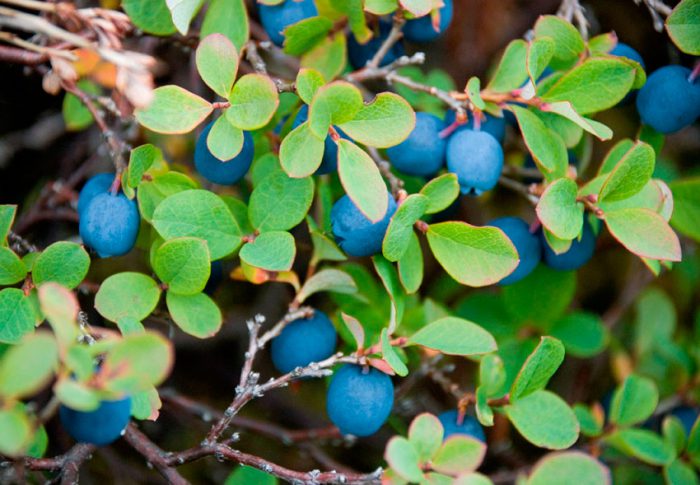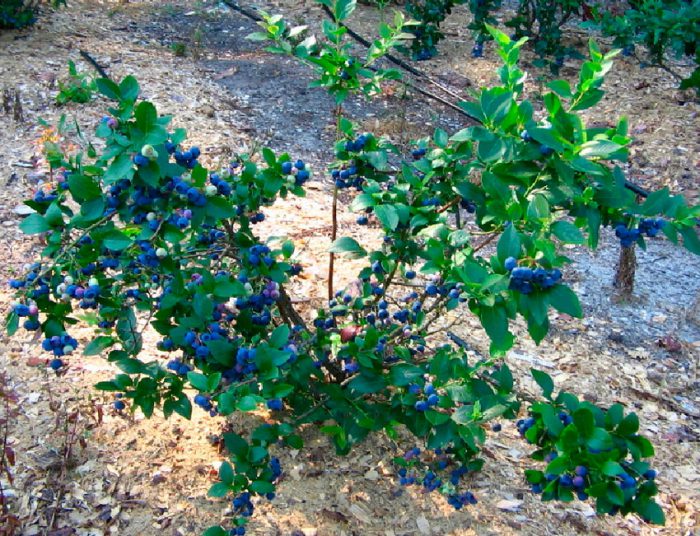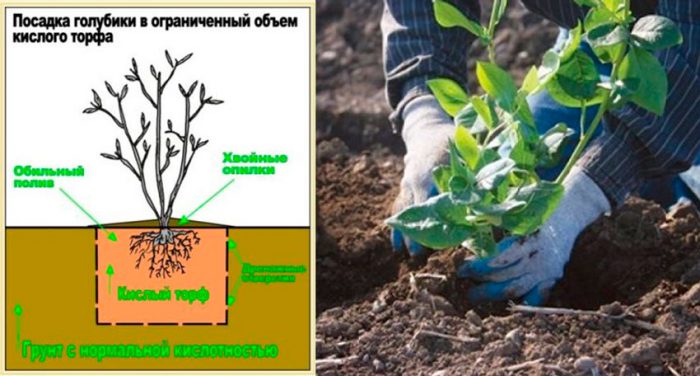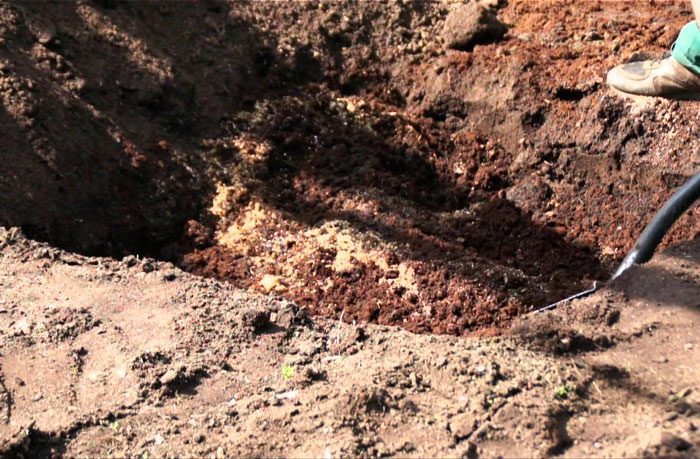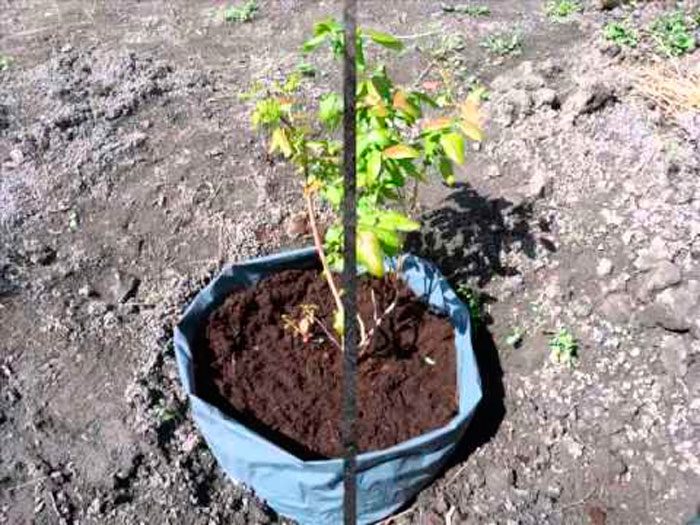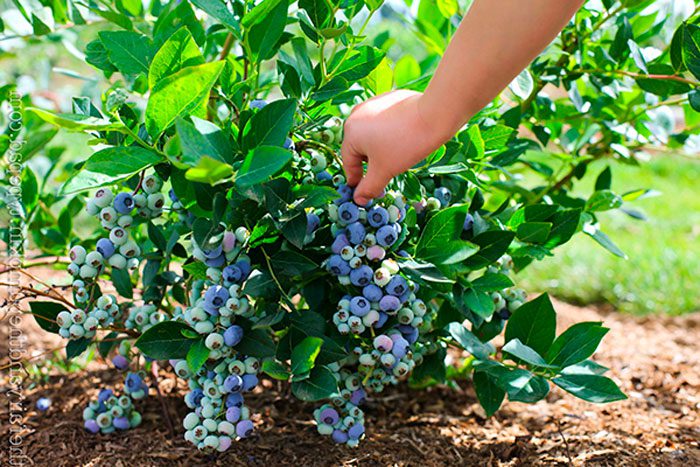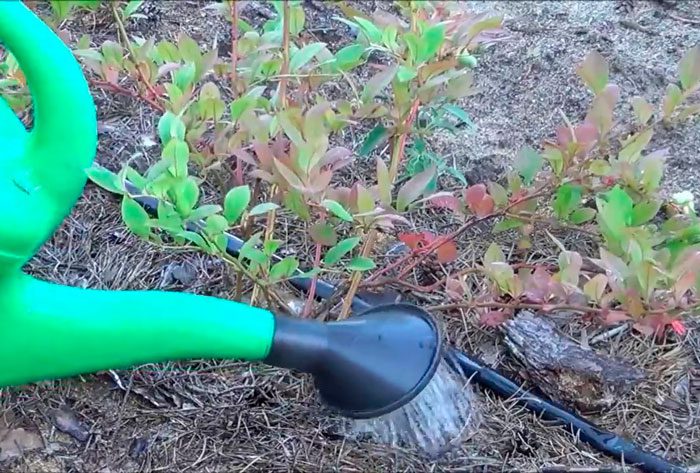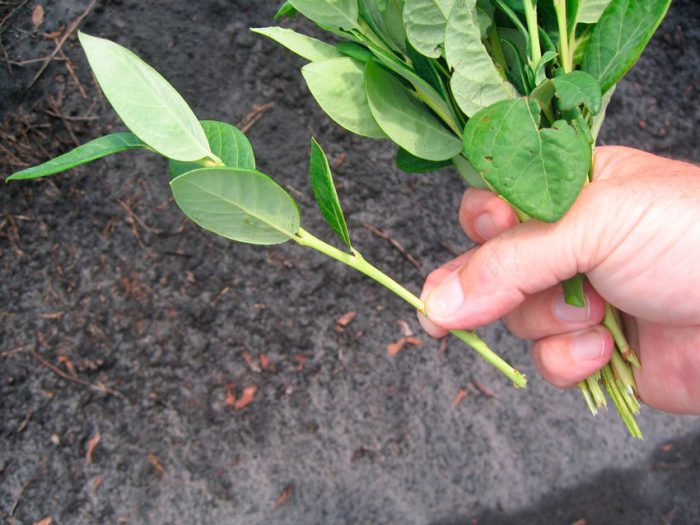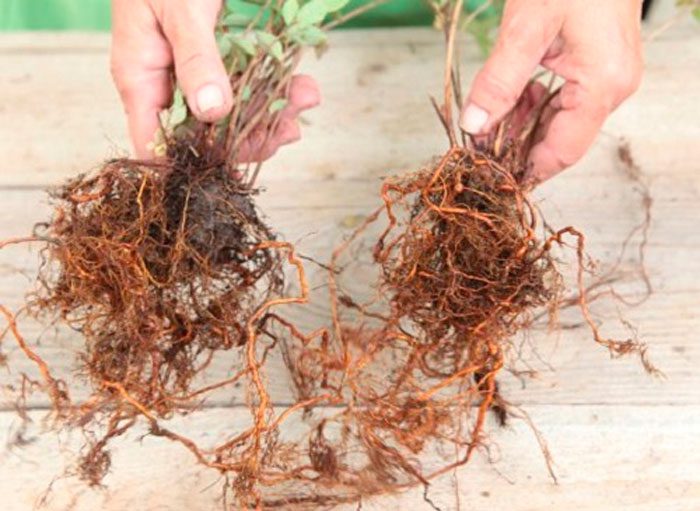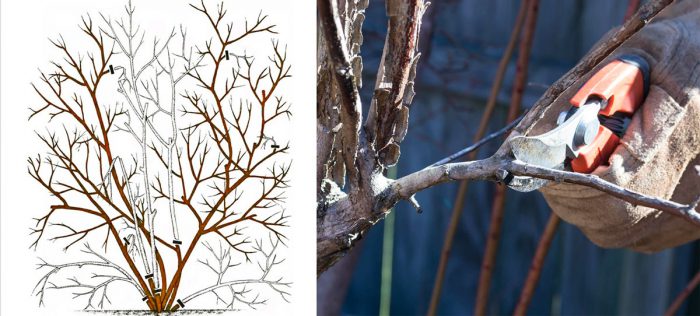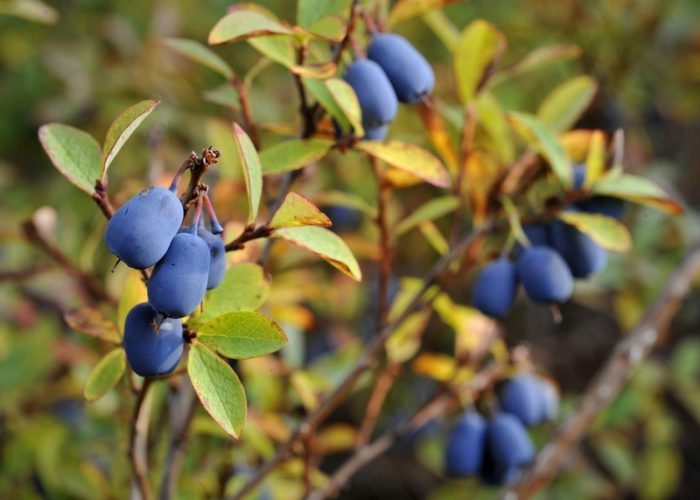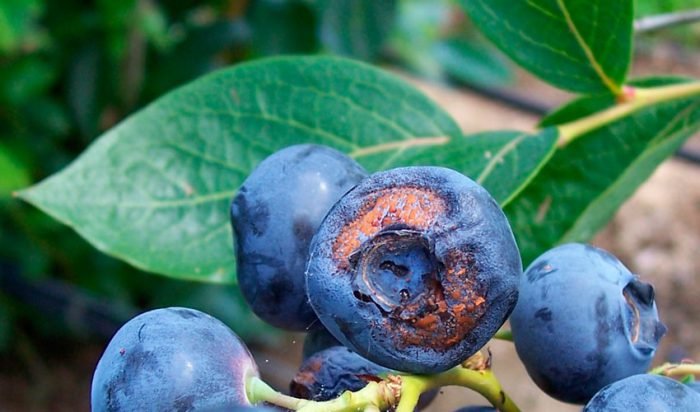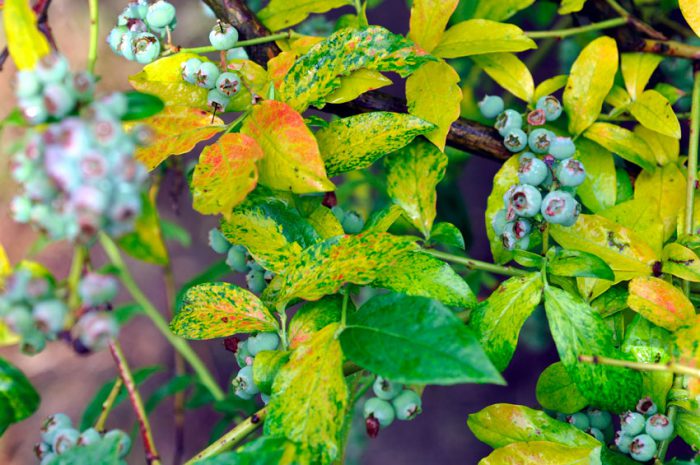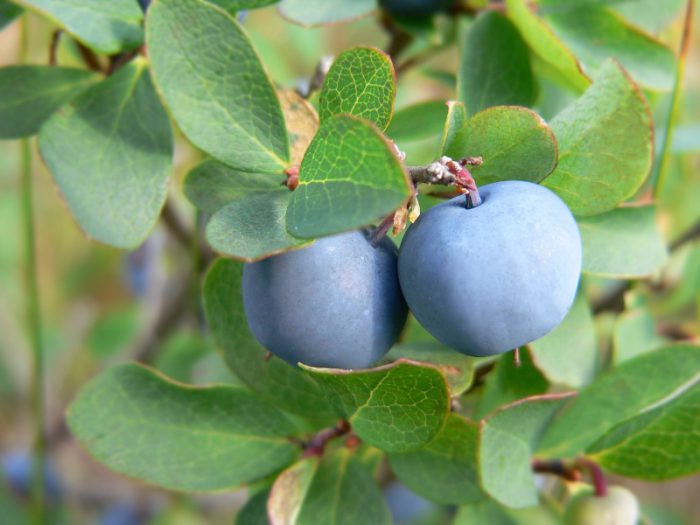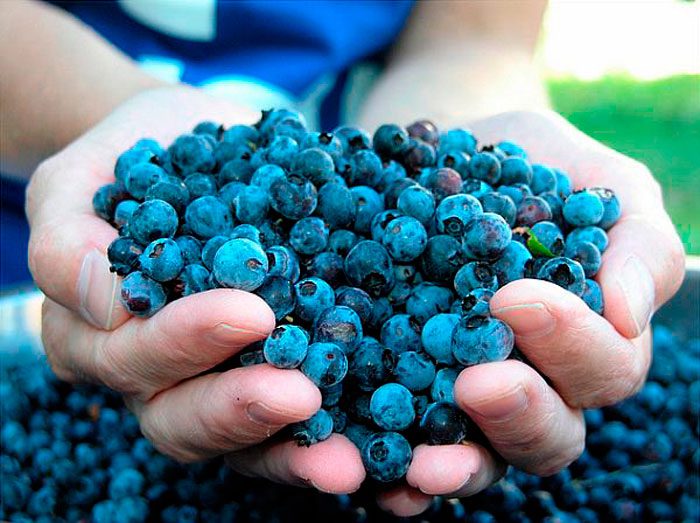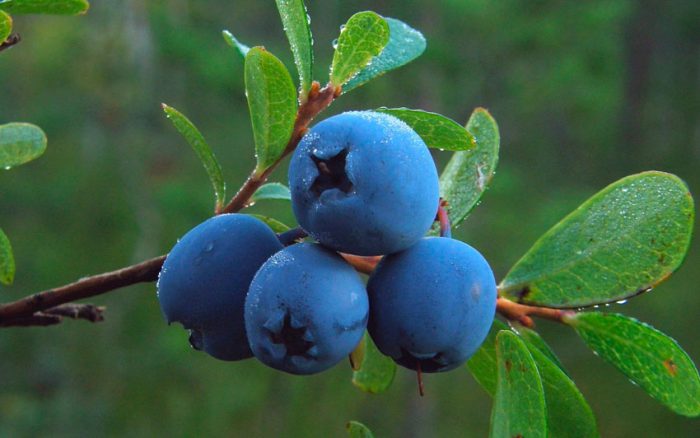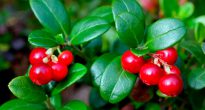The deciduous shrub Vaccinium uliginosum, also called marsh blueberry, or marsh blueberry, or stunted blueberry, is a type species of the genus Vaccinium of the heather family. In nature, it can be found in regions with a cold and temperate climate throughout the Northern Hemisphere. In North America, the range of common blueberry begins in California and ends in Alaska, and in Eurasia it covers an area from Mongolia and the Mediterranean to Iceland. Such a plant has a large number of popular names, for example: gonobel (gonobol, gonoboy, gonobob), blue grapes, drunkard (drunkard, drunk berry, drunkard), foolish (foolish, foolish, foolish person) and titmouse. Fool, gonobob, drunkard and other similar "negative" names were given to the plant by mistake, many people were sure that because of it a headache begins to be severe, as if from a hangover. However, severe headaches are actually caused by wild rosemary, which prefers to grow next to blueberries. Blueberry fruits are considered very valuable, and therefore its popularity among gardeners is growing every year. In addition to the common blueberry, which grows in temperate and cool areas, there is one more species, called tall garden blueberry (Vaccinium corymbosum), it comes from America, where it has gained great popularity among gardeners. In the United States and Canada, blueberries are more popular than black currants. Canadian and American hybrids and varieties of this type of blueberry are gradually becoming more and more popular with mid-latitude gardeners, but they can be grown only in the southern regions of Russia or in Ukraine.
Content
Blueberry features
The genus vaccinium includes cranberries, blueberries, lingonberries and blueberries. Some scientists are convinced that blueberries and blueberries are one and the same plant, while other botanists oppose this identification. The fibrous root system has no root hairs. On the surface of cylindrical erect branches there is a brown or dark gray bark, and the stems are colored green. The height of common blueberry does not exceed 100 centimeters, while tall blueberries can reach up to 200 centimeters in height and even more.Short-petiolate alternate leaf plates are small, solid, smooth and rigid, their length is about 30 mm, and their width is up to 25 mm. Their shape is lanceolate or obovate, there is a blunt apex, and the edges are slightly bent down. There is a waxy bloom on the front surface of the leaves, which is why they have a greenish-blue color, the seamy surface is of a paler color, there are strongly protruding veins on it. Small drooping five-toothed flowers have a water-lily-shaped corolla of white or pale pink color, which reaches 60 mm in length, there are also 8 to 10 stamens. Flowers are located on the upper parts of last year's branches, while they sit in several pieces. The oblong blue fruits reach 1.2 cm in length and weigh about 1 gram. On their surface there is a bluish bloom, the skin is thin, and the color of the pulp is pale green. The weight of the fruits of tall blueberries is 10-25 g, while in America about 10 kilograms are collected from one bush on average. In warm areas of middle latitudes, up to 7 kilograms of fruit can be harvested from one bush of this type of blueberry, but only if the weather conditions are favorable. When choosing a seedling, remember that not all foreign varieties can be cultivated in mid-latitudes, since there are varieties of late ripening, and their fruits have time to ripen only by 30 percent. In this regard, in mid-latitudes it is recommended to cultivate common blueberries or those varieties of high-growing blueberries that are mid- or early-maturing.
Planting garden blueberries
You can plant blueberries in open soil during spring and autumn. It should be noted that experienced gardeners are advised to do this in the spring, since during the summer period the seedling will be able to root well and gain strength, which will allow it not to suffer from frost in the winter. Growing blueberries is relatively easy, but harder to harvest and maintain.
Soil for blueberries
A well-lit area should be chosen for planting blueberries, while shrubs should be protected from gusts of wind. If it is planted in a shaded place, then the yield will be poor, and the quality of the fruit will be low. This plant is very demanding on the soil; only acidic soil is suitable for its cultivation, the pH of which should be 3.5–4.5. Also, experienced gardeners for planting blueberries recommend choosing the site that has been fallow for several years. The fact is that this plant reacts negatively to any predecessors. Remember that a quiet, well-lit place with peat-loamy or peat-sandy well-drained soil is ideal for planting. In the event that there is no area in the garden that is ideal for growing such a shrub, you can do it yourself.


Watch this video on YouTube
Planting blueberries in spring
Planting in open soil in the spring is done before the buds swell. When purchasing a blueberry seedling, you should carefully choose the type and variety. It is essential that the plant you choose is suitable for growing in your area. If the climate in the region is cold enough, then it is best to purchase a seedling of a short Canadian blueberry. In warm regions with long hot summers, various varieties of garden blueberries can be grown. Also, when choosing a seedling, it is very important to take into account the timing of fruit ripening, they need to be compared with the climatic features of your region. The fact is that if you make the wrong choice, then the berries simply will not have time to ripen before the onset of frost.
Experts advise purchasing seedlings with a closed root system (in a container or pot).However, when planting blueberries in open soil, it should be borne in mind that its roots are so fragile that they simply cannot turn around on their own in the ground. In this regard, it cannot simply be transferred from the container to the landing hole. Before planting, the pot with the seedling will need to be immersed in a container of water for 15 minutes. Then the plant should be carefully removed from the pot. With your hands, gently, slowly, knead the earthen ball and try to straighten the blueberry roots.
The size of the planting pit for common blueberries and garden blueberries is the same, namely, 0.6x0.6 meters, while its depth should be 0.5 meters. If several tall seedlings are planted, then a distance of 1.2 meters is observed between them, for medium-sized varieties it should be equal to 1 meter, and for low-growing ones - 0.5 meters. The row spacing should be 3–3.5 meters. After the pit is ready, it is recommended to loosen its bottom and walls, which will improve air access to the root system of the seedling. Next, you need to make sure that the soil in the pit is acidic. To do this, a mixture consisting of sawdust, sand, high-moor peat and pine needles is placed on its bottom; 50 grams of sulfur must be poured into it to oxidize the resulting substrate. Mix the resulting substrate well and tamp it down. It is not required to pour fertilizer into the soil. At the same time, it is not recommended to use organic matter for feeding blueberries, as it promotes alkalization of the soil. When the pit is ready, a plant must be placed in it, its roots are carefully straightened, while they must be directed in different directions. It should be noted that after planting, the root collar of blueberries should be buried 30 mm into the soil. The planted plants need watering. When the liquid is absorbed into the soil, its surface should be sprinkled with a layer of mulch (bark, peat, pine sawdust or straw), the thickness of which should be 12 centimeters.


Watch this video on YouTube
Planting blueberries in autumn
Planting blueberries in autumn is done in the same way as in spring. However, if a seedling of the first year of life was used for planting, then after planting, using a pruner, it will be necessary to remove all weak branches from it, and it is recommended to shorten the remaining ones by ½ part. In the event that the seedling is older than 2 years, then it should not be cut.
Blueberry care
During the season, it will be necessary to make several loosening of the surface of the trunk circle, while their depth should be within 8 centimeters. However, remember that loosening the soil is often not necessary, as this can cause the plant to dry out. It should also be noted that the blueberry root system is horizontal and very close to the soil surface (about 15 centimeters), so try not to injure it while loosening. Due to the fact that the roots of the plant are located close to the surface of the soil, it is very important to cover it with mulch. Loosening of the soil can be done without first removing the mulch, while it should be replenished 2 or 3 times per season. Timely weed control is also important, it is pulled out immediately after it appears on the site.
For the normal growth and development of the shrub, it still needs to be watered, fed and cut on time.
Watering blueberries
Water the blueberries correctly. In this case, the gardener must develop a special scheme for watering blueberries. So, the soil should always be damp, but it should be taken into account that water after irrigation should not stay in the soil for more than two days, otherwise this may cause the death of the bush. As a rule, watering is carried out twice a week, 2 times a day (in the morning and evening), while 10 liters of water is poured under 1 bush at a time. Particular attention should be paid to watering in July and August, when fruiting is observed, because it is at this time that flower buds are laid for the next year. If blueberries do not receive the required amount of water at this time, this will negatively affect the amount of harvest both this and next year. If it is very hot outside, then the bushes will need not only watering, but spraying, this will help to avoid overheating. Plants need to be sprayed early in the morning or after 4 pm.
Blueberry feeding
Blueberries do not have any special requirements for the nutritional value of the soil, however, they respond well to mineral fertilizers. Top dressing is recommended in early spring, when sap flow begins and the buds swell. In this case, organic fertilizing should be completely excluded. For feeding such a shrub, it is recommended to use the following fertilizers: potassium sulfate, superphosphate, ammonium sulfate, magnesium sulfate and zinc sulfate. The fact is that they are absorbed by the plant very well. The application of nitrogen-containing fertilizers (ammonium sulfate) takes place in 3 stages. So, 40 percent of the nitrogen fertilizers necessary for blueberries must be applied when the sap flow just begins, 35 percent - in the first days of May, and 25 percent - in the first days of July. Only one shrub per season requires 70 to 90 grams of this fertilizer. From July until next spring, the plant will no longer need nitrogen. The introduction of phosphorus-containing fertilizers (superphosphate) should be done in the summer and autumn, while 100 grams of the substance is taken for 1 shrub. Zinc sulphate and potassium sulphate are applied once a season and taken 2 grams per shrub. Magnesium sulfate is also applied once a season, while 15 grams of the substance is taken per bush.


Watch this video on YouTube
Blueberry propagation
Blueberries can be propagated by seeds or by one of the vegetative methods. Choose a completely healthy shrub and harvest full fruit from it. From them you need to get the seeds and dry them a little. In the autumn, they are sown on training beds, first the soil on them should be dug up with the introduction of sour peat. In the event that sowing is expected in spring, then the seeds will need stratification. To do this, they need to be placed on a refrigerator shelf for 12 weeks. Sowing is carried out in pre-made grooves, while the seeds are buried by 10 mm, and they are sprinkled on top with sand mixed with peat (3: 1). In order for seedlings to appear as soon as possible, the crops must be properly looked after. They need warmth (from 23 to 25 degrees) and not very high humidity (about 40 percent), and they also need to be watered, weeded and loosened on time. The emerging plants should be fed with nitrogen-containing fertilizer in the spring, but this should be started from the second year of life. After 2 years, the seedlings can be transplanted to a permanent place.
Reproduction of blueberries by cuttings
If you need a way to more quickly and reliably propagate blueberries, it is best to resort to cuttings. In the spring, before the sap flow begins, or in the fall, at the end of the leaf fall, you should start harvesting rhizome cuttings. Try to keep the cutting length from 8 to 15 centimeters, while the thicker the shoot, the better. The fact is that if the shoot is thick, then the appearance of roots will occur relatively quickly, and also growth will begin earlier. To activate the survival rate, the harvested cuttings must be removed for 4 weeks in a place with a temperature of 1 to 5 degrees. Cuttings are planted obliquely in peat mixed with sand (1: 3). Then everything is covered with a five-centimeter thick layer of the same soil mixture. With proper care, already after 2 years, the cuttings will become developed and strong seedlings that can be transplanted to a permanent place.
Propagate blueberries and divide the bush
To propagate such a plant, some gardeners resort to dividing the bush. To do this, a part of the bush is dug out and divided into divisions, while each of them must have a rhizome, in length reaching from 50 to 70 mm. Immediately after dividing the bush, the delenki are planted in a new place. Plants grown from seeds give their first fruits when they are 7 or 8 years old. Blueberries grown using vegetative propagation begin to bear fruit in their fourth year.
Blueberry pruning
In order for the shrub to bear fruit regularly, it will need timely pruning. It is carried out in the spring before the buds swell. In the event that, in summer or autumn, branches and stems injured or damaged by the disease are found on the bush, they will need to be cut and destroyed, there is no need to wait for spring. For newly planted seedlings, it is imperative to remove all flowers during the first year, which will allow the blueberries to grow and develop correctly. The formation of a powerful skeleton of a plant should be dealt with from the second to the fourth year of life, this will allow the shrub to avoid injury if there is a rich harvest. To do this, you need to cut out all diseased, weak, frost-damaged or branches lying on the surface of the soil. Be sure to cut out all root growth. After the plant turns 4 years old, in addition to diseased and weak branches, all stems that are more than 5 years old should be cut, while from annuals, it is necessary to leave from 3 to 5 most powerful shoots. If the shrub is spreading, then all drooping lower branches will need to be removed from it. And if the plant is a straight-growing variety, it will be necessary to thin out in the middle of the bush. Make sure that there is no closing of branches between neighboring bushes, as this will have an extremely negative effect on the quality and ripening time of berries.


Watch this video on YouTube
How to care for the fall
After fruiting begins, experts advise harvesting blueberries once every 7 days. It is best to pick berries in the morning, but only after the dew has evaporated. After the fruit is colored in the desired color, it should ripen on the bush for several more days. After the dense berries are soft, they can be picked. During this time, there is an increase in the weight of the fruits, as well as an increase in the amount of sugar in them. After picking, berries should be immediately removed to the refrigerator shelf, they should be stored at a temperature of 0 to 2 degrees for 14 days. It should be borne in mind that fruits can absorb odors, so they must be isolated from other products. Berries can be frozen, then they will be stored much longer. To do this, they are thoroughly washed and poured into 1 layer in the freezer. After the berries are completely frozen, they are placed in one container and put back into the freezer for storage. If desired, the fruits can be dried, in this form they are suitable for the preparation of tasty compotes, as well as healing infusions and decoctions.
In regions with frosty winters, blueberries will need a good shelter, since if the air temperature drops below minus 25 degrees, then the shrub can freeze out even more if there is little snow. After the bush is freed from the fruits, you should start preparing it for wintering. Throw a loop of wire or twine over the branches of the plant and slowly pull them to the surface of the site. After that, the bush must be fixed in this position and covered with burlap (it is not recommended to use plastic wrap, because blueberries will not breathe under it), spruce branches should be put on top. After snow falls on the street, spruce branches from above will need to be thrown at them. The winter shelter should be removed from the plant in the spring. In the event that winters in your region are warm and snowy enough, then blueberries will be able to survive them without shelter, especially for winter-hardy varieties.
Blueberry pests and diseases
Blueberry pests
You need to plant and care for blueberries following agrotechnical rules, in this case the plant will be healthy and strong. But even such bushes need preventive treatments for pests and diseases. Birds inflict great harm on blueberries, or rather, to its harvest, they peck berries ripening on the branches.To avoid this, you can resort to the following trick, a metal mesh with small cells is carefully pulled over the bush. Harmful insects cannot cause significant damage to the shrub, with the exception of rare years, when in spring the bushes literally cover the beetles and beetles. They eat flowers and eat foliage, this has an extremely negative effect on the productivity of the shrub. In addition, the root system of the plant can be damaged, since the beetle larvae eat up its roots. Also, leafworms, aphids, pine silkworm caterpillars and scale insects can settle on the bush. It is necessary to collect the beetles and their larvae by hand in a timely manner, which is recommended to be drowned in a container filled with salt water. The easiest way to get rid of other pests is by treating the shrub with Karbofos or Aktellik. Spraying blueberries with the same drugs for prophylaxis is recommended in early spring and after all the fruits have been collected.


Watch this video on YouTube
Blueberry diseases
Most often, the plant is affected by fungal diseases such as: stem cancer, drying of branches (phomopsis), gray rot (botrytis), fruit monoliosis, physalsporosis, white spot (septoria) and double spot. It should be remembered that almost all such diseases arise due to stagnation of liquid in the root system of the shrub, and this usually happens due to poor soil permeability or due to improper irrigation regime. At the first signs of the disease, all necessary measures should be taken to eliminate the causes of its occurrence, otherwise the plant may die. Preventive treatments are carried out at the beginning of the spring period and after the harvest has been harvested, and Bordeaux liquid is used for this. The affected bush should be sprayed with Topaz 2 or 3 times, while the interval between procedures should be 7 days. You can replace Topaz with drugs such as Topsin, Bordeaux liquid or Fundazol.
Also, this plant is susceptible to mycoplasma and viral diseases such as: dwarfism, filamentous branches, mosaic, necrotic and red ring spot. These diseases are not amenable to treatment, in this regard, the affected specimens must be dug up and destroyed as soon as possible.
If the rules of agricultural technology are violated, this will negatively affect the condition and health of the plant. For example, it happens that the foliage of a plant begins to turn yellow. It first turns pale green and then turns yellow. As a rule, the problem lies in the fact that the soil on the site is not acidic. To correct the situation, peat should be added to the soil, after some time the color of the foliage will become normal, or rather, the young leaf plates will be painted green. Foliage yellowing is also observed when the plant lacks nitrogen. At the same time, along with the yellowing of the foliage, the growth of the stems stops, and the fruits become smaller. Nitrogen-containing fertilizers are needed for plants, they must be applied at the beginning of each season in 3 stages (described in more detail above). If the foliage changes its color to red, then this is the first symptom of drying stems or branch cancer.
Blueberry varieties with description
At the moment, all blueberry varieties are divided into 5 groups:
- Low-growing varieties... This group is based on the species - angustifolia blueberry, which is crossed with the genetic material of northern blueberry and myrtle-leaved blueberry.
- Northern tall varieties... They are highly resistant to frost and late fruiting. They were obtained on the basis of North American species, namely, tall blueberries using the genetic material of common blueberries.
- Southern tall varieties... They are complex hybrids created using northern tall blueberries and several species of blueberries native to the south.The resulting varieties are resistant to drought. In addition, these varieties are less demanding on soil pH.
- Semi-tall varieties... These varieties were obtained as a result of the fact that tall blueberry varieties continued to saturate with common blueberry genes. The resulting varieties are very resistant to frost, they are able to withstand even severe cold (up to minus 40 degrees).
- Rabbit eye... In this group, the species is considered the basis of varieties - blueberry twig. The resulting hybrids can quickly adapt to hot climates and poor soil. Such varieties have a rather long growing season, therefore they are not recommended to be grown in regions with a temperate and cool climate. The fact is that before the onset of winter frosts, most of the crop does not have time to ripen.
Of these groups, only northern tall varieties are recommended to be cultivated in mid-latitudes. The most popular northern tall varieties:
- Bluegold... This mid-season variety is medium-sized. The shape of the bush is semi-spreading, and the medium-sized fruits have a sour-sweet taste. Highly resistant to frost. Bushes need to be thinned often, and they also need enhanced pruning.
- Patriot... It is a mid-season and tall variety. The height of the spreading plant does not exceed 150 centimeters. Large fruits of pale blue color are covered with dense skin. Ripening occurs in July and August. Yields are consistently high, so up to 7 kilograms of fruit are harvested from 1 plant. It is frost-resistant and also resistant to diseases typical of blueberries.
- Chippewa... This variety is early ripe and medium-sized. The height of the bush is about 100 centimeters. The pale blue fruits are large and medium in size and have a very sweet taste. The plant has a high resistance to frost, it is able to withstand temperatures as low as minus 30 degrees. This variety can be cultivated both in containers and in the country.
- Duke... The variety is tall, late flowering, but early maturing. The height of the bush is about 200 centimeters. The bushes bloom at the end of the spring frost. Due to its early ripening, this variety has stable high yields, while large and medium-sized fruits do not shrink over the years. It has a very high resistance to frost, but the plant needs more pruning.
- Sunrise... Medium-high grade. Spreading bush, it has a relatively weak shoots. As a result, such a plant does not need to be cut frequently. Dense large fruits with a slightly flattened shape, high palatability and mature in mid-July. With proper care, up to 4 kilograms of berries are harvested from one plant. This shrub often suffers from return frosts in the spring.
- Chanticleer... Medium-sized variety. The bush has ascending branches. Flowering begins after the end of the spring frost. The medium-sized pale blue fruit has a sweet-sour taste and ripens in the last days of June. About 4 kg of berries are removed from 1 plant. The plant has high frost resistance.
- Northland... Low-growing variety. The sprawling bush reaches a height of no more than 100 centimeters. Differs in stable high yield. Up to 5-8 kg of berries are removed from 1 bush, they are dense, medium-sized and blue in color. The fruits are of high taste. This plant is highly resistant to frost and a short growing season. Before the onset of winter, all the fruits have time to ripen. This shrub is also used in decorative floriculture, as it is compact and undersized.
- Elizabeth... Late tall variety. Sprawling bush. Erect stems and shoots have a pale red tint, which is considered characteristic of varieties that are very resistant to frost. 4-6 kg of fruits are harvested from one plant.This shrub is one of the varieties in which the fruits have the highest taste. The fruits are large (about 2.2 cm in diameter), fragrant and very sweet in taste, the beginning of their ripening occurs in the first days of August. Before the onset of winter, all the fruits do not have time to ripen.


Watch this video on YouTube
Blueberry properties: benefits and harms
Useful properties of blueberries
After the blueberry was carefully studied by scientists, it became clear that it is the owner of the most unique qualities. It helps to improve the activity of the pancreas and intestines, protect the body from radioactive radiation, strengthen the vascular walls, and slow down the aging of nerve cells. She is the owner of anti-scurvy, anti-inflammatory, hypotensive, choleretic, anti-sclerotic, and also cardiotonic effect. The blueberry berry contains provitamin A, vitamins B1, B2, C, PP, which is responsible for the elasticity of the capillaries of the epidermis and reduces the risk of varicose veins, there are still 6 amino acids, phosphorus, calcium and iron, while it is found in the fruits of this plant in a form in which the comparative is easily absorbed by the human body. Blueberries have proven their effectiveness in the treatment of atherosclerosis, capillarotoxicosis, rheumatism, hypertension, sore throat and other diseases.
The juice from the fruits of such a plant is recommended for use in diseases of the gastrointestinal tract, diabetes mellitus and fever. The fruits themselves help to eliminate eye spasm and restore vision. They also contain pectins, which help to bind radioactive metals and cleanse the body from them. The fruits also contain highly active antioxidants that prevent cancer cells from forming in the body.
The fruits of such a shrub in alternative medicine are used fresh, and infusions, decoctions and tinctures are also prepared from them. It will be useful to eat them for both absolutely healthy and sick people, because fresh fruits help to strengthen the body's immune forces and saturate it with vitamins. But fruits, stems, and leaf plates of such a plant have healing properties.
Blueberry decoction is recommended for use in heart disease. To prepare it, you need to pour 2 large tablespoons of chopped leaves and young branches into an enamel pan, pour 200 ml of freshly boiled water into it. Cover the container with a tight lid and incubate in a water bath for 30 minutes. The cooled broth must be filtered, while squeezing out the remains. The resulting broth is brought to 200 ml with boiled water. They drink it 1 large spoon 4 times a day.
Blueberry infusion is very effective for diarrhea and dysentery. To prepare it, you need to combine 1 large spoonful of dried blueberries with 200 ml of freshly boiled water. Incubate the mixture for 5 minutes. over low heat, and then 15 minutes. under the lid. Drink the remedy for 1 large spoon 4 times a day.
Also, a decoction of blueberries is indicated for diabetes. To prepare it, you need to combine 1 large spoonful of chopped dried leaves and branches of blueberries with 400 ml of freshly boiled water. Mix 5 min. kept on low heat. After the drink has been infused under the lid for 60 minutes, it must be filtered. The broth is drunk for half a glass three times a day before a meal.


Watch this video on YouTube
Contraindications
Absolutely everyone can use blueberries, as they have no contraindications. But you still need to know when to stop, because if you eat a lot of blueberry fruits uncontrollably, they can harm the body. When overeating, a person experiences vomiting, nausea, or an allergic reaction.Large amounts of antioxidants in the body reduce the amount of oxygen entering the muscles, which leads to impaired muscle functions in the body. With moderate consumption of blueberry fruits in the summer, and with the regular use of compotes, jams, infusions and decoctions from it in winter, it is quite possible to become a long-liver, which is the shrub itself, which, with proper care, can live for 100 years.

